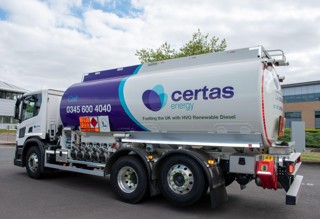The planned fuel duty increase for September 2014, expected to be worth 1.61p per litre, will be cancelled.
The Chancellor George Osborne announced the freeze in the Autumn Statement today (Thursday, December 5).
In total, fuel duty will have been frozen for nearly four and a half years, the longest freeze for over 20 years. Average pump prices are 13ppl lower than if the Government had implemented the fuel duty escalator, and will be 20ppl lower by the end of the Parliament.
The Treasury says that this means that it currently costs the typical motorist £7 less to fill up their tank, and will cost £11 less by the end of the Parliament.
ACFO chairman Damian James said: "The move gives some stability to fleets in their budget forecasting and is welcome at a time when the green shoots of economic recovery are sprouting.”
In total, the Government claims it will have eased the burden on motorists by £22.5 billion over this Parliament. This equates to a saving of £680 for a typical motorist, £1,300 for a small business with a van, and £21,000 for a haulier by 2015-16.
To incentivise a shift to cleaner, cheaper fuel, the Autumn Statement 2013 also commits to maintain the differential between the main rate of fuel duty and the rate for road fuel gases such as Liquefied Natural Gas (LNG) and Compressed Natural Gas (CNG) for 10 years.
This, it says, will provide businesses with the certainty they need to invest in alternatively fuelled commercial vehicles, supporting the de-carbonisation of the UK transport sector and contribute to reducing the transport fuel costs of businesses.
The Government says it is taking further action to address costs for motorists.
To bring down the high costs of fuel on motorways, new comparison road signs will be trialled which will show prices at different service stations along a route, making it easier for drivers to find the cheapest deal and encouraging competition on prices.
From 2014, whiplash cheats, whose fraudulent compensation claims have driven up average motor insurance premiums, will be scrutinised by new independent medical panels.
This, it says, will ensure that only evidence from accredited professionals can be considered and will mean people can no longer profit from exaggerated or fraudulent compensation claims.
In addition, the statutory maximum price of the MOT test for a car will be frozen at £54.85 until 2015.
James said: “Removing the tax disc reduces the administrative burden on fleet managers and vehicle leasing companies particularly in terms of forwarding a new disc to drivers.
“However, prior to the withdrawal of the tax disc from October 2014, ACFO wants to be assured that enforcement keeps up with the development."
Osborne told the House of Commons: “Britain’s economic plan is working, but the job is not done.
“We need to secure the economy for the long term.”
The Office for Budget Responsibility (OBR) has revised its forecast for GDP growth up from 0.6% to 1.4% in 2013 and from 1.8% to 2.4% in 2014. It has also forecast GDP growth of 2.2% in 2015, 2.6% in 2016 and 2.7% in 2017 and 2018.
From 2012 to 2018, the OBR has revised up cumulative real GDP growth by 1.4 percentage points.
It also expects the rate of inflation to slow between 2013 and 2016, returning to the 2% target in the second half of 2016.
Osborne says the Government remains on course to meet the fiscal mandate one year early, with the cyclically adjusted current balance reaching a surplus of 1.6% of GDP in 2018-19.
Public sector net borrowing as a percentage of GDP is forecast to have halved by 2014-15.
Excluding the effects of the transfers to and from the Asset Purchase Facility, public sector net borrowing is forecast to be in surplus by 0.1% of GDP in 2018-19.
Public sector net debt as a share of GDP is forecast to peak at 80% of GDP in 2015-16 – a year earlier than forecast at Budget 2013, but a year later than the supplementary target for debt – before falling each year and reaching 75.9% of GDP in 2018-19.























Login to comment
Comments
No comments have been made yet.